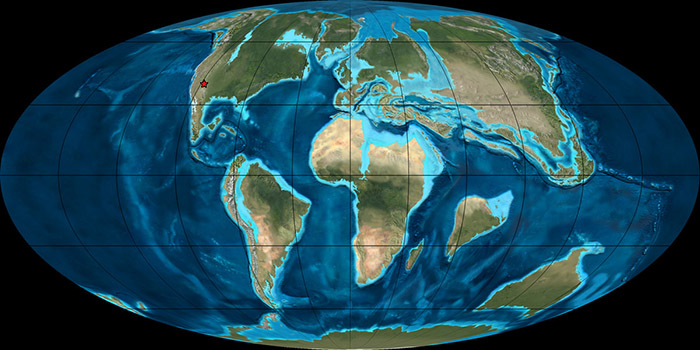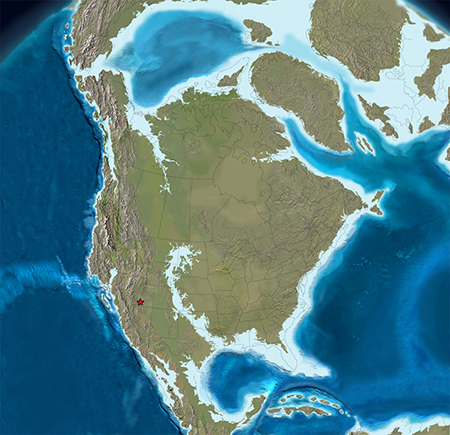
Map of Continents Through Time

Time in History: 66 million years ago (Cretaceous-Paleogene Border)
Environment Parameters & Graphs of Carbon & Oxygen
|
 |
Question of the Day:
Would is be possible to create a real Jurassic Park and bring dinosaurs back to life with stored samples of DNA?
Key Concepts
Dispatch
It’s nearly dinnertime, and the runners and their support crew are nowhere to be found. The evening camp is set up, the cooks have arrived, the education team is here, but the runners are not. The culprit is believed to be a combination of fatigue and logistics, nothing catastrophic, though one can’t help but wonder exactly what happened. The lesson of the day for the students is about another disappearance. 66 million years ago a massive asteroid hit the earth, causing a dust cloud that blacked out the sun and very rapidly most of the dinosaurs on Earth were killed. Only one obscure group of dinosaurs survived, the ancestors of today’s birds. The flying ones, the swift ones; with that in mind, the runners finally ambled into camp. They may not have been as swift today, but they made it, and it was those resilient few who began the next great era in our run through time, the rise of the mammals.
| Daily Video | Expert Video |
|---|---|
Photos of the Day
Coming Soon!
Character of the Day: Chicxulub Asteroid
While we have been focusing on animals as our featured character for each day of the expedition, we could not help but chose the Chicxulub asteroid for the day 5 character, as it is credited with causing the extinction of the non-avian dinosaurs. The Chicxulub asteroid crater was discovered in the Yucatán region of Mexico by geophysicists about 35 years ago. The crater is more than 180 km (110 mi) in diameter, making it one of the largest confirmed impact structures on the planet. It is estimated that the impacting asteroid that formed the crater was at least 10 km (6 mi) in diameter. The age of Chicxulub asteroid impact and the Cretaceous-Paleogene boundary (K–Pg boundary – when the dinosaurs went extinct) coincide precisely, leading to the suggestion that whatever caused the crater also caused the extinction of non-avian dinosaurs on Earth. In March 2010, following extensive analysis of the available evidence covering 20 years worth of data, 41 international experts from 33 institutions concluded that the impact at Chicxulub triggered the mass extinction of dinosaurs. Subsequently, in 2012 Dr. Gerta Keller, Princeton University, published comprehensive studies of both the Chicxulub and Deccan Trap area’s K-T record. Dr. Keller was able to establish quite convincingly that the extinction event, as recorded in the extinction of several major groups of planktonic foraminifera (shelled microscopic one-celled organisms) actually post-dates the impact by over 200,000 years. On the other hand, the second, and by far the largest of the Deccan Trap eruptions coincides almost exactly with the extinction event, with marine ecosystems crashing stepwise as the 200,000 year-long eruption continued. This deadly 1-2 punch overwhelmed both marine and terrestrial ecosystems, leaving fish, turtles, and crocodilians as the largest living things. However, mammals quickly caught up and surpassed them in both the oceans (whales) and on land. Some have speculated that the impact may have caused the massive Deccan eruption by disturbing an already active mantle hot spot and causing it to erupt more voluminously than normal.
Youth Ambassador Activity
Yesterday we visited Grand Staircase Escalante National Monument’s Kaiparowits Plateau, arguably the most plentiful bed of late Cretaceous dinosaur fossils in the world. Our exercise revealed that 75 million years ago this location hosted a warm and wet subtropical jungle that supported an abundance of life. Dominant among the animals were the dinosaurs, which grew to immense sizes. Unfortunately for the dinosaurs this dominance did not last. A cataclysmic event occurred 66 million years ago that dramatically changed the balance of life on Earth, setting the stage for the proliferation of birds, the rise of mammals, and ultimately man. Today we will examine the dramatic environmental changes that lead to the end of the era of the dinosaurs. As you are running today I would like you to consider what sets a mass extinction event apart from the normal course of life on Earth.